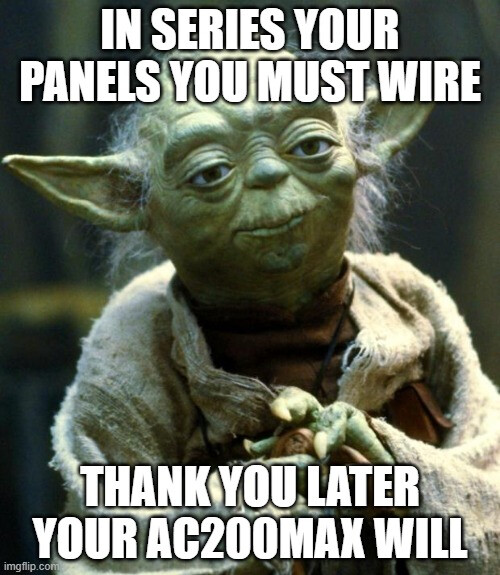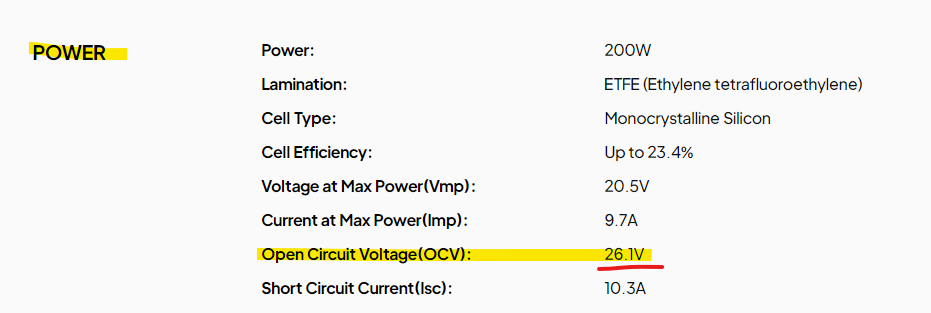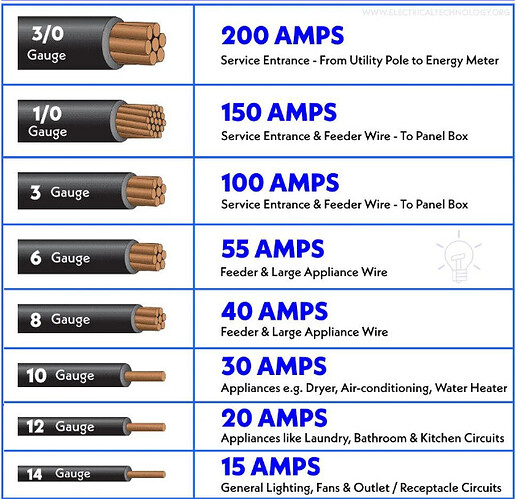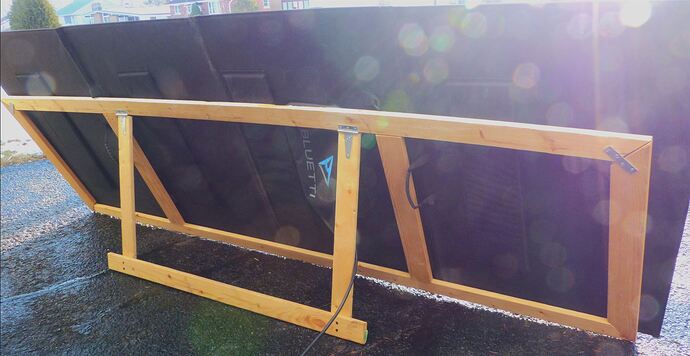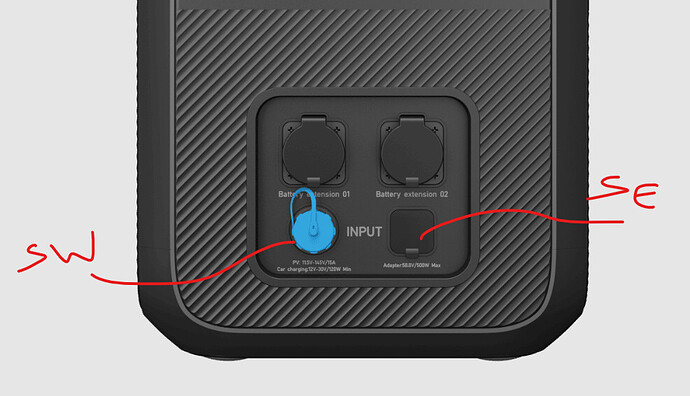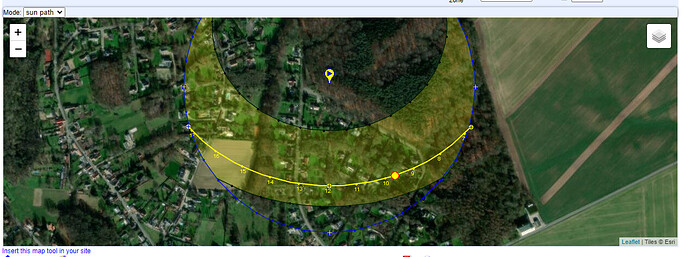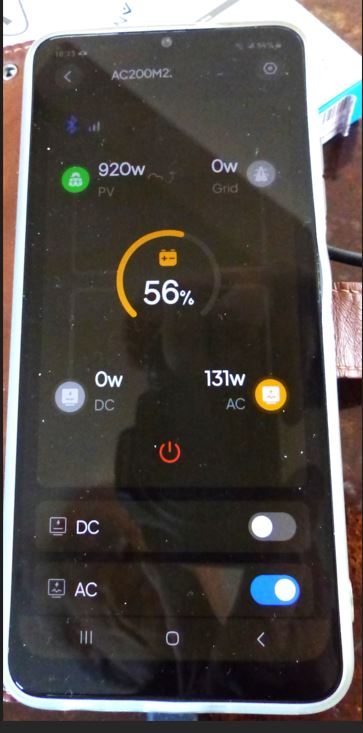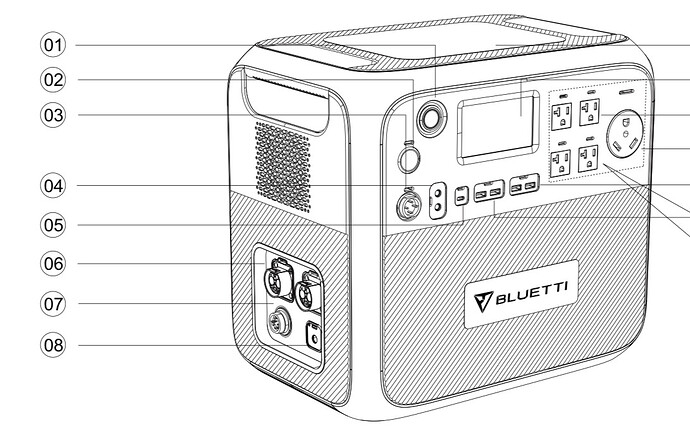4 PV200 to AC200MAX, how to “best” connect them.
Hi Y’all, thanks for a great community of folks, topics, answers, discussion and such! Apologies for “stupid” question and details below.
I have the “age-old” question, I’m sure… of - how to best…
I have the AC200MAX, for about 1 year now (from Bluetti), really only use occasionally.
I have had 3 PV200’s connected to it in series, several times just in the backyard and such… decent sun when using them, and move or tilt them around some if some shadowing comes into the situation; couple of trees in the yard’s two back corners… nothing drastic.
Anyway, I have a 4th PV200 in route to be delivered in the next couple of days (from Bluetti, thanks!), and just curious if there are some tips/ideas from you pros, as to how I should “best” connect them to the AC200MAX? Meaning, the series vs. parallel and such is a little confusing to me yet. And exactly what connectors are needed to do parallel, if there is a way to do the 4 that way, and/or what do you folks recommend :-)?! I have the Bluetti basic picture from the website for the series connection… but since I am introducing the 4th into the scenario, wondering option/ideas may be good with the 4 panels now.
Hope that helps with some information and appreciate your support!
Have a great day,
M.
Hi @MarkBr1 - nice setup there.
Short answer: 4 in series is your best choice with AC200Max and PV200.
.
Green guy said so, not me:
.
Joke aside, bit of explanation now.
.
Let’s have a look at the tech specs of your AC200MAX:
Let’s keep in mind that 145Voc as it is the upper voltage limit. That’s the only item that truly matters here; it means “highest voltage that can be safely applied on your AC200MAX”. Above that, you fry your AC200MAX. It’s a good practice to stay 10% below that limit since the Voc of a panel is measured at 25°C, and panels have a tendency to produce higher voltages in colder conditions.
.
Stay safe: consider 130V your upper input limit to offset this phenomenon.
.
Now let’s look at the specs of your PV200:
.
- Open circuit voltage is 26V.
- Basic math: 3x PV200 in series means 3x26V = 78V.
- Now add a 4th panel in series: 4x26V = 104V.
You could even add a 5th in series and that would reach 130V. Safe limit reached.
Now, series or parallel?
Let’s look back at the specs, and locate the max amp input of your AC200MAX: 15A.
At max power, your PV200 produces 9.7A (spec uses the label “Current at Max Power Imp” - Imp = Intensity at Max Power): 9.7Amps.
.
So:
- In series, you increase the voltage (4x PV200 → 104V and 9.7A)
- In parallel, you increase the current (aka intensity, amps), so 4x PV200 → 26.1V and 38amps. Oof.
.
“Oof” : that’s a lot, you’d need thick wires, 8 American Gauge is about 8-9mm². That’s a big wire.
.
But then, let’s review a little theory here: - The Voltage is imposed by the source (aka your panels)
- The load must have a high enough voltage tolerance to not be burned by that source-imposed voltage.
- Amps are pulled by the load (aka your AC200MAX)
- The load will never pull more amps than it needs / can pull.
Considering this, even though your source (4x PV200 in parallel) can produce up to 38A, your load can only pull up to 15A.
So in top conditions, you’d only draw 40% of that maximum.
Presented the other way around, let’s imagine you drive a car with 100hp. It only produces this much when you floor it. Coasting it on the motorway will perhaps pull 20-30hp at most. AC200MAX is your engine, and in spite of having up to 38Amps of “fuel” flowing to it, it can only pull 15amps.
.
Last but not least, what about “2P2S”, like twice two panels in series?

Yes, but no.
That would lower the voltage to 52V, but would still make the system produce up to 18A, which is 3A above how much your AC200MAX can pull.
.
So, don’t.
2P2S is a great way to make the most of sub-optimum sun conditions AND/OR lower the voltage to meet the requirements of a weaker unit. Take AC180, it has a hard limit to 60V. There, you’d need to 2P2S your 4 PV200 to stay below the 60V limit.
You have AC200MAX. Your only issue is managing the shadows now.
.
Last note about shadows:
- while 4 in series make the least shadow impact your entire setup (all panels operate at the lowest voltage of the string)
- in parallel, panels produce the maximum they can disregarding the production of other panels wired in parallel. So there are added risks of cell damage, imagine: panel 1 is fully shaded, panel 2, 3 & 4 have full sun. Panel 1 might suffer from “hot spots”, which are cells acting as resistors, possibly resulting in permanent damage (or accelerated ageing) of your panel(s).
.
Hope I didn’t overload you with info
Keeping in mind that I don’t recommend any form of parallel wiring in your case, here is a link to the kind of product you’d need to wire panels in parallel. For the sake of research ![]()
.
PV200 uses MC4 like most panels do. The XC60 intermediate plug (yellow) isn’t meant for parallel connection, neither is the 5mm barrel connector of your AC200MAX. So it all happens at the level of the MC4 plugs. You must use MC4 splitters and be careful about polarities. I’ve seen a guy manage to reverse the polarity of his input and fry a solar controller (not a Bluetti one, I insist).
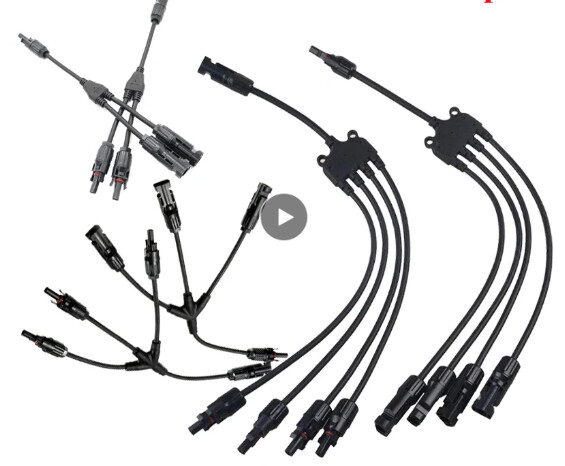
…
For a low voltage setup (max 28V) I use this (4p):
https://www.aliexpress.com/item/1005006339411967.html?spm=a2g0o.order_list.order_list_main.42.32481802llhyWT
For a medium voltage setup (max 58V) I use this (2p):
https://www.aliexpress.com/item/33004938050.html?spm=a2g0o.order_list.order_list_main.101.32481802llhyWT
Note: I don’t profit from sharing those links (ie no affiliate links), these just work nicely for me.
Hello there: MarkBr1:
You have gotten some good advice already, so I can’t add a lot to that because it’s all good. But what I can do is tell you my AC200MAX story
I purchased my AC200MAX back in the spring of 2023 along with 1 PV200 panel. I didn’t really do much with it until the fall. I had purchased it (along with the EB70) to use as a reliable backup system for a few home appliances, but I have since decided to try and use it as much as possible to ease the amount of Hydro from the utility company.
Presently I am running just 2 fridges/Freezers and my next step is to connect my AV, computer, and electronics hooked up as well. I am also able to run my gas furnace if need be (there were technical difficulties to do with grounding issues and insurance, but everything is good now.) I’m not using the equipment every day yet because this winter we haven’t had much sunshine, but that is changing.
For this setup I am using 2 PV350 (voc 37.5 each / imp 9.2A and one PV200 voc 26.1 / imp 9.7A Total voc=101.1) solar panels (bluetti) in series with a combined output maximum total of 900W. That’s tied into the PV input section of the AC200Max / B300 using 75 feet of MC4 - 10AWG wires that feed the AC200MAX .
As of now, I can charge my batteries with good solar at around 15-20% per hour, while no load is on the MAX.
So far this is good for me as long as I get 4–5 hours of sun at least every few days.
2 x PV350 and 1x PV200
I just received another B300 (total 2 now) so my next step I’m waiting for better weather, and also I want to make some more stands for my Solar Panels, because these stands I am using were designed for the PV200 panel.
Oversized panel on PV200 Stand
Then I will connect my remaining 2 PV200’s to the Bluetti D050s enhancer and connect that to the AC input on the MAX to try and max out all the input possibilities.
I have not wired any part of this into my main hydro panel, but instead have alternate wiring that I have hidden behind walls etc. Just my way of doing it.
Hoping to go indefinitely soon.
Derceto,
Thank you, Thank you!! I appreciate your great advice and great information! And your fun-loving green-guy helper :-). You have been very gracious in your explaining of many good points and suggestions. Thank you, you are (and many others here in this arena) great value to this community!
Very nice of you to share all you did.
In series the panels will be setup, for weekend playing with them and such. All of your information you have supplied is great learning material and useful!
I am thinking (yeah, I know, not a good idea for me to do ;-)) - but wondering if I could somehow have two of the four PV200 panels, on say one side of the (general size yard) back yard, and the other two on the other side… say two facing Southwest to catch the sun, and the other two facing more West - - somehow have them still in the series scenario and going to the AC200MAX. I do have two of the Bluetti DC505 enhancers, one will/does have the Bluetti 420 folding panel, going to the B230 (one) I have, Just FYI. The other enhancer, I was planing to use if I can get the second B230 battery at some point - use the second enhancer with another Bluetti 420 panel.
So just more lame-brain thinking on my part, of maybe an idea(s) to wonder/try.
Thanks again! Have a great day, across the big pond :-)!
Hi Liberty,
Thank you for your note/information - Awesome :)! And yes Derceto did/does have some good advice! Nice folks y’all are! Thanks!!
Your setup sounds/looks great! Envious for sure. I just Very novice as you can tell… and just am just doing a little… loads of laundry or some other simple tasks with the small setup I have :-).
I have 2 30ft MC4 10AWG wiring, and 1 20ft of the same, and 1 10ft of the same… to hang out my first floor window or sliding glass door - to the outside/backyard, panels. Haha, yeah a chinsey setup for sure… but just seeing what I can do/get started with. I am sure I need much more items and knowledge for sure!
Thank you for sharing your story/info! Very nice to hear, see and pull ideas from ;-).
Thanks and may you have a great rest of your week :-)!
Certainly, catching morning and afternoon sun is a great scenario. Based on your latitude, it’s always a good practice to appreciate the perfect angle & tilt. See tool here. Took me a little while to figure out how to make the most of it, but then it really comes in handy.
…
Just keep in mind to NOT have different angles on the same string. Larger units have 2 built-in MPPTs, so two strings can enjoy very different conditions feed the device.
.
In your case, considering that you have 2x D050S, it opens up a world of possibilities.
Blue PV input plug obviously takes a string, say a SW one, while the other string is independently managed by your DC enhancer handling the panels facing SE. This way, you have 2 separate MPPTs, and panels facing different orientations can live nicely without impeding the whole production.
.
And yes, that 2nd D050s can feed the external B230 adding a third orientation/shading setup.
.
Careful, solar power virus is contagious and well on its way there ![]()
.
That’s the spirit ![]() And come regularly on the forum, you’ll notice that Bluetti often creates friendly contests where you showcase your solar setup, and tehre’s always a nice prize to win. There’s always a power station and/or battery to win… stay tuned and don’t hesitate to share pics of your setup with us, we’re (almost?) all solar nuts here
And come regularly on the forum, you’ll notice that Bluetti often creates friendly contests where you showcase your solar setup, and tehre’s always a nice prize to win. There’s always a power station and/or battery to win… stay tuned and don’t hesitate to share pics of your setup with us, we’re (almost?) all solar nuts here ![]()
![]()
It’s a cool setup, thanks for sharing.
.
Even though their Imp is very similar (9.2 vs 9.7), I’m still a bit uncomfortable stringing different panels in series. Maybe I’m overly cautious here and you seem pretty well equipped already ![]()
.
Are you happy with D050s?
Cheers ![]()
Regarding the azimuth/angle tool, it got a recent update showing an ovelay on the map itself:
Shows quite accurately where the sun is right now, where it rose, and where it sets tonight. Second half of the page shows how high it is during the day:
In yellow, that’s today. At the moment, the sun is right above 20°. Since my SE has large trees, the sun needs to reach 25° to hit my SE panels; which means I don’t get decent production out of them until it’s 11am. The next dotted line above shows that the problem solves itself in March as, at 9-10am, the sun will already reach 30°, and shine from above the treeline.
.
And idea angle, especially useful with portable panels: 90° - target sun angle.
For instance, to make the most of this low sun, it’s ok to tilt as high as 65 or even 70 if the stand allows it.
.
Hi Derceto: Thanks, I’m glad you like’d my post. I’ve seen some of your posts, and you are always helpful
Concerning mixing panels. My understanding is that the only problem with this setup is that I will lose a little voltage due to the loss of 0.5 amps. Also, it’s important to use proper sized cables for your system(I think I have that right size 10AWG) because I know every little loss will add up.
I also have a D050S unit and will be trying that out soon with my remaining 2 PV200 panels.
Here is a screenshot from the other day using my 2 PV350’s and 1 PV200
The temperature was around minus -9 Celsius or around 16 F.with clear skies.I have a post in the Solar setup category that talks a little about that.
.
Hi. About the D050S enhancer. I have one and have for a while but haven’t used it yet. My plan is to run my remaining 2xPV200 with it and plug it into the AC charge port of the max along with the solar panels going into the PV input.
I’m a little slow getting going on making some more panels, and the weather isn’t that great around here. I’m lucky the last couple of months if I get 1 full sunny day every 5–6 days. But today was a beautiful day, so I tested my new 2nd B300 with the AC200Max to see how long it takes to charge, it obviously takes longer now that I have 2, so my next step is to get the D050S tested.
I’m not sure what to expect concerning the amount of power the unit takes to change the current from DC -AC from my 2 PV200 panels.
If you have any ideas on that, let me know.
Have a good day Derceto
Hi Derceto (and Liberty), wow again some very nice (and nicely put together/explained) information and assistance! Thank you very much for all this info and I will take the advice and use as much of it as I can comprehend ;-)… got it pretty good understood from your great explanation of things, thanks!! The earth/sun tool… well yes that is a bit overwhelming ;-), but looks fantastic and I will play around with that some, much appreciated! I do application support for my day-job work… but that tool is pretty intense, but cool, wow. Thanks again (both of you) for super ideas and friendly communication!! The world needs more of the solar power virus and good folks like you all, to help spread it :-).
Thanks,
Mark
I get back to you ASAP, bit in a rush since yesterday and I want to think that through ![]()
Hey happy to know you’re infected ![]()
![]()
Keep us posted!
…
Oh and solar is even better with the beautiful decices of our favorite brand ![]()
![]()
Ideally an inline ammeter before D050S and comparing with MAX’s reported input would give a very good idea of the conversion loss under different solar conditions.
Side notre, you mention AC charging port; The AC charging port is in reality designed to accept a 58.8V DC input (diagram element 8), so when using a T500 to charge from an AC source, it’s actually supplying DC to the MAX unit. This aligns with the D050S functioning as a DC-DC converter, which is generally more efficient under load conditions. With its maximum capacity rated at 500W and considering that two PV200 panels would at best generate around 400W, we never reach max power. Moreover, mixed conditions might get us less than 200W from them, and there we’re way below design capacity of D050s.
The efficiency of DC-DC conversion is expected to be around 80-95% at high loads for similar devices. These converters usually start to underperform when operating at lower loads, to the point of turning on and off intermittently.
.
Issues such as intermittent clicking sounds from the relays in MAX have been reported under cloudy or dusky conditions, suggesting that the D050S may struggle with insufficient input to initiate the conversion process effectively.
Hi Liberty,
Thanks for sharing. I also thought to connect a PV350 and a PV200 in series, but here was the Bluetti answer last year:
Dear Serban,
Thanks for reaching out to the Bluetti support team.
No, please kindly know that the VOC of the PV200 and the PV350 is different, the higher one will burn out the lower one if connected. You can add another PV200 and connect 2 panels in series to charge the AC200MAX if you want.
I hope it does help.
Best regards,
Aurora
Slightly confused as it clearly works for you…
I sent you a PM I dont know if you got it.
Just let me know,
B
nope, didn’t arrived
Thanks for letting me know. Ill copy my letter from yesterday and resend it .
Hello Serban:
I did in fact string 2 pv350’s and 1 pv200 together in series to run my AC200MAX. Anyway the difference with those 2 panels is fairly minor, and it concerns the current (Amperage).
The PV350 specs are :
Max OCV/VOC= 46.5
Max Current =9.2A
PV200 specs are :
Max OCV/VOC= 26.1
Max Current =9.7A
I had a few people tell me it wasn’t the best thing to do, but I have never encountered any problems.
Perhaps it could cause a problem, or perhaps cause the panels to break down early.
I don’t know for a fact either way, so it is up to you if you want to try that. Otherwise, 2 PV350 panels will work very nicely with the AC200MAX.
Since I wrote the original post last year, I have incorporated some solar panels on the roof.
It makes my life a lot easier.
I still have 2 pv350’s and 1 Pv200 which on snowy days I was using cause my rooftop panels were very difficult to reach and clear. So on occasion I am still using them the same way as before.
The rest of my panels I sold last fall, 2 Pv200’s and 1 PV350 to a neighbour I got interested in solar-powered batteries.
Happy Belated Earth Day by the way,
B
All solar panels have a specific IV(current/voltage) curve they like to operate at for maximum efficiency and power. The more you deviate from this curve, the more waste heat is generated inside the panel, which can shorten its lifespan. Because the PV200 and PV350 have similar current, it would be more so a death by a thousand swords/gradual type thing than a catastrophic-type failure.
Basically what’s happening is the PV200 wants to operate at 9.7A in full Sun and the PV350 wants to operate at 9.2A in full Sun. Since you run them in series, the current stays the same, so the PV200 bogs down to 9.2A. Not a problem in terms of physically running them in series. The current flow remains 9.2A but the energy from the Sun causes some of the lost potential to manifest as “waste” heat. This is different from when the IV curve drops naturally as the sun sets, or when clouds block rays to reduce its intensity. You are manipulating the IV curve physically.
